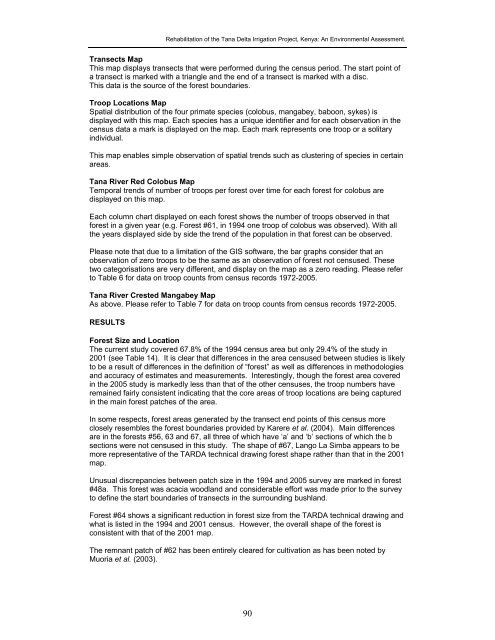Tana Delta Irrigation Project, Kenya: An Environmental Assessment
Tana Delta Irrigation Project, Kenya: An Environmental Assessment
Tana Delta Irrigation Project, Kenya: An Environmental Assessment
Create successful ePaper yourself
Turn your PDF publications into a flip-book with our unique Google optimized e-Paper software.
Rehabilitation of the <strong>Tana</strong> <strong>Delta</strong> <strong>Irrigation</strong> <strong>Project</strong>, <strong>Kenya</strong>: <strong>An</strong> <strong>Environmental</strong> <strong>Assessment</strong>.<br />
Transects Map<br />
This map displays transects that were performed during the census period. The start point of<br />
a transect is marked with a triangle and the end of a transect is marked with a disc.<br />
This data is the source of the forest boundaries.<br />
Troop Locations Map<br />
Spatial distribution of the four primate species (colobus, mangabey, baboon, sykes) is<br />
displayed with this map. Each species has a unique identifier and for each observation in the<br />
census data a mark is displayed on the map. Each mark represents one troop or a solitary<br />
individual.<br />
This map enables simple observation of spatial trends such as clustering of species in certain<br />
areas.<br />
<strong>Tana</strong> River Red Colobus Map<br />
Temporal trends of number of troops per forest over time for each forest for colobus are<br />
displayed on this map.<br />
Each column chart displayed on each forest shows the number of troops observed in that<br />
forest in a given year (e.g. Forest #61, in 1994 one troop of colobus was observed). With all<br />
the years displayed side by side the trend of the population in that forest can be observed.<br />
Please note that due to a limitation of the GIS software, the bar graphs consider that an<br />
observation of zero troops to be the same as an observation of forest not censused. These<br />
two categorisations are very different, and display on the map as a zero reading. Please refer<br />
to Table 6 for data on troop counts from census records 1972-2005.<br />
<strong>Tana</strong> River Crested Mangabey Map<br />
As above. Please refer to Table 7 for data on troop counts from census records 1972-2005.<br />
RESULTS<br />
Forest Size and Location<br />
The current study covered 67.8% of the 1994 census area but only 29.4% of the study in<br />
2001 (see Table 14). It is clear that differences in the area censused between studies is likely<br />
to be a result of differences in the definition of “forest” as well as differences in methodologies<br />
and accuracy of estimates and measurements. Interestingly, though the forest area covered<br />
in the 2005 study is markedly less than that of the other censuses, the troop numbers have<br />
remained fairly consistent indicating that the core areas of troop locations are being captured<br />
in the main forest patches of the area.<br />
In some respects, forest areas generated by the transect end points of this census more<br />
closely resembles the forest boundaries provided by Karere et al. (2004). Main differences<br />
are in the forests #56, 63 and 67, all three of which have ‘a’ and ‘b’ sections of which the b<br />
sections were not censused in this study. The shape of #67, Lango La Simba appears to be<br />
more representative of the TARDA technical drawing forest shape rather than that in the 2001<br />
map.<br />
Unusual discrepancies between patch size in the 1994 and 2005 survey are marked in forest<br />
#48a. This forest was acacia woodland and considerable effort was made prior to the survey<br />
to define the start boundaries of transects in the surrounding bushland.<br />
Forest #64 shows a significant reduction in forest size from the TARDA technical drawing and<br />
what is listed in the 1994 and 2001 census. However, the overall shape of the forest is<br />
consistent with that of the 2001 map.<br />
The remnant patch of #62 has been entirely cleared for cultivation as has been noted by<br />
Muoria et al. (2003).<br />
90

















